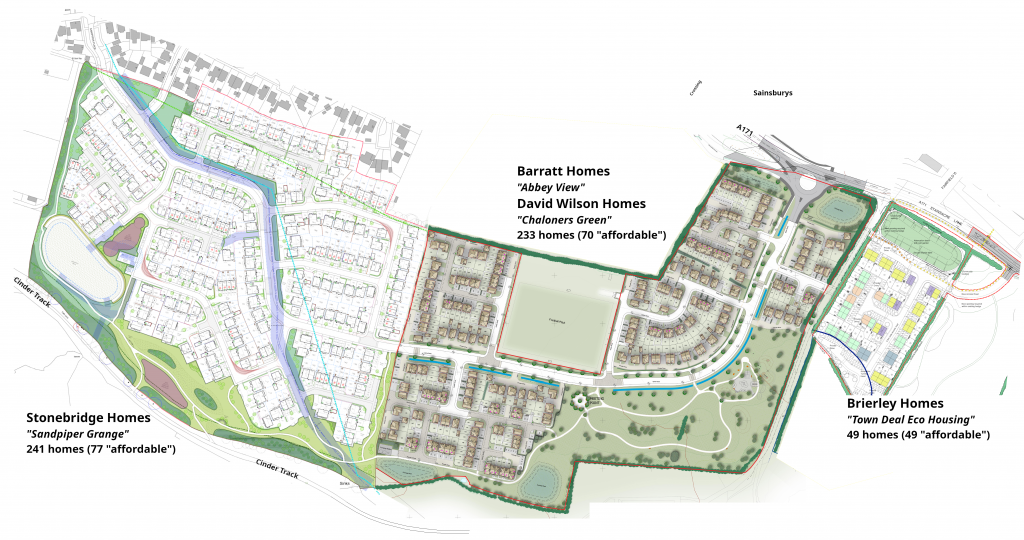The recent push for housing in Whitby has focussed on providing so called “affordable housing”. A typical development will provide the order of 30% of the total number of houses as “affordable”. There is pressure to reduce this to 20% in the near future, meaning that a typical development will be contributing significantly fewer properties that local people can afford, and that larger amounts of land will be required to provide the housing that the populace needs. This will only serve to put more pressure on resources such as green space. If we take a typical development in Whitby with, say, 100 homes, meaning 30 of them will be classed as “affordable” (using the current 30% allocation). With the current arrangement,
- 25% of the 30 will be applicable to the UK Government “First Homes” scheme – 8 properties.
- 70% of the remainder (22) will be affordable/social rented – 15 properties.
- 30% of the remainder (22) will be other intermediate (discount sales, shared ownership etc) – 7 properties.
The UK Government definition of “affordable” does not utilise the average earnings in the location that it is applied to, meaning that in an area with relatively high house prices but low earnings, the “affordable” homes are anything but affordable. In the above example, use of the First Homes scheme in Whitby at a discount of 30% will mean that those homes will not be affordable to people on average salary for the town; the discount percentage would likely need to be closer to 50% to make these homes genuinely affordable to local people on average salary. Similarly the shared ownership homes will not be affordable here, with shared ownership being a relatively expensive way of purchasing.
| Location | Mean | 10th % | 20th % | 25th % | 30th % | 40th % | Median | 60th % | 70th % | 75th % | 80th % | 90th % |
| Harrogate & Knaresborough | 34,203 | x | x | x | x | 24,935 | 29,357 | 31,935 | x | x | x | x |
| Richmond & Northallerton | 29,859 | 9,738 | 14,052 | 17,473 | 21,127 | 24,296 | 27,717 | 31,615 | 36,789 | 39,970 | 42,556 | x |
| Scarborough & Whitby | 28,081 | 9,633 | 13,684 | 16,394 | 18,823 | 21,982 | 26,281 | 30,008 | 33,927 | 36,582 | 35,945 | x |
| Selby | 38,187 | x | 20,889 | 21,805 | 24,805 | 27,181 | 28,877 | 34,842 | 41,837 | 43,872 | x | x |
| Skipton & Ripon | 32,566 | x | 10,418 | 13,481 | 15,535 | 18,936 | 27,126 | 32,447 | 38,410 | 41,768 | x | x |
| Thirsk & Malton | 29,953 | x | x | x | 21,863 | 25,048 | 27,935 | 30,575 | 37,026 | 39,266 | x | x |
The Scarborough and Whitby constituency has amongst the lowest earnings of all NYC constituencies, and with mean gross earnings of £28081 (2024) and the percentile distribution shown, it is easy to see why an average house price in Whitby of £240000 is out of reach to many people, even with a 30% discount for the First Homes scheme. A typical mortgage lender may be willing to lend up to maybe 4.5 times gross annual salary, consequently the upper limit available on a mortgage for that salary would be around £116000. This exemplifies why the 30% discount for the First Homes scheme would not result in an affordable house for a typical Whitby resident (though it would in Scarborough, where property prices are somewhat lower).
Some sample current prices,
- Broomfield Farm Phase 1 “Abbey View” has 1-bed apartment at £150k and 2-bed house at £200k
- Green Lane “Eskdale View” has 3-bed house at £310k
Let’s take an example of the cheapest house on Broomfield Farm Phase 1 “Abbey View”, a 2-bed house at £204000, and assuming they have a 15% deposit.
- With a 30% discount, the purchase price would be ~£140000. So with a deposit of £21000, anyone earning ~£26500 could contemplate buying it meaning the lower 62% percentile could not afford it.
- With a 40% discount, the purchase price would be ~£122000. So with a deposit of £18000, anyone earning ~£23000 could contemplate buying it, meaning the lower 52% percentile could not afford it.
- With a 50% discount, the purchase price would be ~£102000. So with a deposit of £15000, anyone earning ~£19500 could contemplate buying it, meaning the lower 40% percentile are still priced out of the market, but at least they would now have hope of being able to buy in their home town, with it being almost within reach.
Needless to say, this example is for the cheapest new build house. Where it is a young family needing a 3-bed home the affordability curve moves along and things become more difficult, though you likely then have 2 salaries to take into account.
If we look at the 1-bed apartment. With a 30% discount the purchase price would be £105000, so with a 15% deposit that means a mortgage of £82500, meaning anyone earning gross salary of £18500 could contemplate this.


